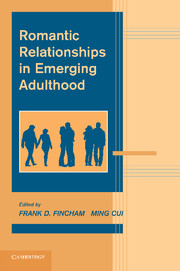Book contents
- Frontmatter
- Contents
- List of Contributors
- Foreword
- PART I INTRODUCTION
- 1 Emerging Adulthood and Romantic Relationships: An Introduction
- PART II CONCEPTUAL AND METHODOLOGICAL FOUNDATIONS
- PART III THE DEVELOPMENTAL CONTEXT OF ROMANTIC RELATIONSHIPS IN EMERGING ADULTHOOD
- PART IV RELATIONSHIP PROCESSES IN EMERGING ADULTHOOD
- PART V PRACTICAL IMPLICATIONS
- Index
- References
1 - Emerging Adulthood and Romantic Relationships: An Introduction
Published online by Cambridge University Press: 06 December 2010
- Frontmatter
- Contents
- List of Contributors
- Foreword
- PART I INTRODUCTION
- 1 Emerging Adulthood and Romantic Relationships: An Introduction
- PART II CONCEPTUAL AND METHODOLOGICAL FOUNDATIONS
- PART III THE DEVELOPMENTAL CONTEXT OF ROMANTIC RELATIONSHIPS IN EMERGING ADULTHOOD
- PART IV RELATIONSHIP PROCESSES IN EMERGING ADULTHOOD
- PART V PRACTICAL IMPLICATIONS
- Index
- References
Summary
This chapter offers a very brief orientation to the construct of emerging adulthood and introduces the reader to the remainder of the book.
WHAT IS EMERGING ADULTHOOD?
In contemporary western society, adolescence begins earlier and adulthood (e.g., marrying, becoming parents) comes much later than in prior generations (Arnett, 2000, 2004). Today's young people leave home at about age 18 or 19, but most do not marry, become parents, and find a steady job until much later in their twenties. For most young people, the late teens to mid-twenties is a time with “both excitement and uncertainty, wide-open possibility and confusion, new freedoms and new fears” (Arnett, 2004, p. 3). Consequently, this period has been proposed as a unique and important developmental stage that is distinct from adolescence and young adulthood.
Arnett (2000, 2004) referred to this period between ages 18 to 25 as “emerging adulthood” and described it as having several distinct features. First, it is a period of continued identity explorations. During this stage, emerging adults become more independent of their parents than they were as adolescents, but have not yet committed to adult roles and responsibilities. In the course of exploring possibilities, emerging adults clarify their identities by answering such questions as “What kind of person am I?” and “What kind of person should I find as a partner through life?” Second, emerging adulthood is an age of instability, with emerging adults shifting between choices in love and work and moving from one residence to another.
- Type
- Chapter
- Information
- Romantic Relationships in Emerging Adulthood , pp. 3 - 12Publisher: Cambridge University PressPrint publication year: 2010
References
- 7
- Cited by



